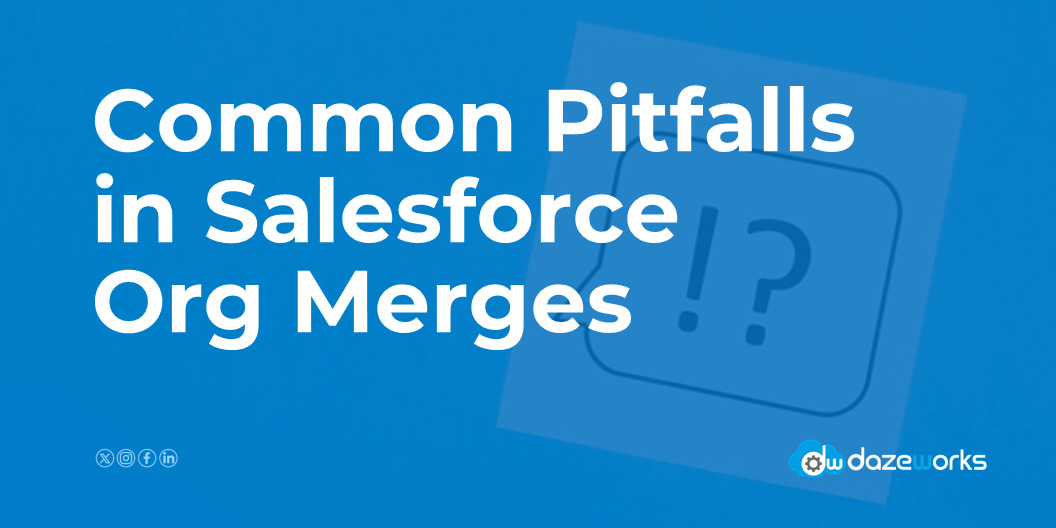
Common Pitfalls of Salesforce Org Merges
minutes read
Are you considering merging your Salesforce orgs? While this may seem like a smart move to optimize and streamline your business processes, it is important to proceed with caution. Without careful planning and execution, you could find yourself facing a disaster rather than reaping the benefits. In this article, we will explore the common pitfalls that organizations encounter during a Salesforce org merge. Whether you are navigating issues related to data migration, customization conflicts, or user adoption challenges, we have got you covered.
Lack of Planning and Preparation
One of the most common pitfalls in Salesforce org merges is the lack of proper planning and preparation. Many organizations underestimate the complexity of the process and fail to allocate sufficient time and resources for it. Without a clear roadmap and well-defined objectives, you are setting yourself up for failure.
To avoid this pitfall, start by conducting a thorough assessment of your existing orgs. Identify the key stakeholders, understand their requirements, and define your goals for merges. This will help you establish a solid foundation for your project and ensure that everyone is on the same page.
Next, develop a detailed project plan that outlines the steps, timelines, and resources required for the transition. Consider potential risks and challenges and devise contingency plans to mitigate them. By investing time in planning and preparation upfront, you can minimize disruptions and maximize the chances of a successful merge.
Data Integrity Issues
It is crucial to ensure that your data is accurate, complete, and consistent throughout the process. Failure to do so can result in data loss, duplication, or corruption, leading to dire consequences for your business operations.
To mitigate this risk, start by conducting a thorough data audit. Identify the key data sets that need to be migrated or consolidated and assess their quality. Clean up any duplicate or outdated records and standardize your data to ensure consistency. Develop a data mapping strategy to map the fields and objects between the orgs and establish clear rules for data transformation and validation.
Ineffective Communication and Collaboration
Organizations overlook the role of communication and collaboration in the merger process. This leads to misunderstandings, conflicts, and delays. Poor communication can also result in resistance from stakeholders and hinder user adoption.
This is why it is important to establish clear lines of communication and create a communication plan. Identify the key stakeholders and define their roles and responsibilities in the process. Regularly communicate updates, progress, and challenges to keep everyone informed and engaged.
Encourage open and transparent communication channels, such as regular team meetings, email updates, and collaborative tools. Foster a culture of collaboration and encourage feedback from all stakeholders. By prioritizing effective communication and collaboration, you can ensure that everyone is aligned and working towards a common goal.
User Adoption and Training Issues
If your users are not comfortable with the new system or do not understand its benefits, they may resist the change or use it incorrectly. This can lead to decreased productivity, increased support requests, and a negative impact on your business operations.
Therefore, invest in comprehensive user training and support. Develop a training plan that covers the key features and functionalities of the new org, as well as any changes or enhancements. Provide hands-on training sessions, online tutorials, and user guides to help your users navigate the transition smoothly.
Encourage user feedback and address any concerns or questions promptly. Establish a support system, such as a helpdesk or knowledge base, to provide ongoing assistance to your users. By prioritizing user adoption and training, you can empower your users and ensure that they are equipped to leverage the full potential of the merged or consolidated org.
Customization Conflicts and Compatibility Issues
If your orgs have different customizations, workflows, or integrations, merging them can be a complex and time-consuming process. Failure to address these conflicts and ensure compatibility can result in system errors, data inconsistencies, and user frustration.
Start by conducting a thorough analysis of the customizations in each org. Identify any conflicts or incompatibilities and develop a plan to resolve them. Consider the impact of the merge on existing workflows, reports, and dashboards, and update them accordingly.
Work closely with your IT team or Salesforce consultants to develop a migration strategy that preserves the key customizations while ensuring compatibility. Test the merged or consolidated org rigorously to identify and resolve any issues before rolling it out to your users. By addressing customization conflicts and compatibility issues proactively, you can ensure a seamless transition for your organization.
Security and Access Control Challenges
Security and access control are critical considerations in a Salesforce org merge. If not handled properly, you may inadvertently compromise the security and privacy of your data, exposing your organization to significant risks.
To mitigate this risk, start by conducting a comprehensive security audit of your existing orgs. Identify any vulnerabilities, gaps, or inconsistencies in your security settings and access controls. Develop a security plan that outlines the steps and measures required to ensure a secure transition.
Consider the access requirements of different user groups and define roles and permissions accordingly. Implement robust authentication and authorization mechanisms to protect your data from unauthorized access. Regularly monitor and review your security settings to identify and address any potential threats.
Conclusion
Merging or consolidating Salesforce orgs can be a complex and challenging process. However, with careful planning, effective communication, and a focus on data integrity, user adoption, customization conflicts, and security, you can ensure a smooth transition that aligns with your business objectives. By understanding the common pitfalls and implementing best practices, you can avoid costly mistakes and achieve a successful Salesforce org merge.
